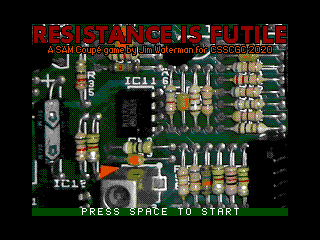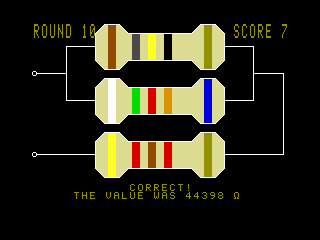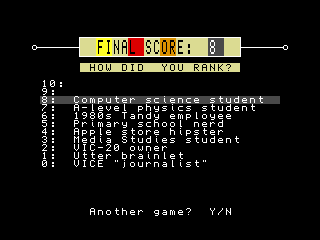It’s Jim Waterman’s final entry! And to go out with a bang rather than a whimper, he has run me ragged again, making me install yet another emulator in order to play his newest masterpiece, Resistance is Futile, which has been developed for the Spectrum’s younger cousin, the SAM Coupé. The SAM is a decently equipped computer, but was released at the wrong time, when the 16-bit machines were gaining prevalence. This, along with a lack of software support (you’d struggle to fill even a Mini-CD with SAM software), doomed it to commercial failure, with only 12,000 units sold during the three years it was on the market.
 Once we’ve loaded the game from disk, the intro screen appears, in gorgeous, attribute-less glory. It’s almost disconcerting to see the full-colour screens of the SAM Coupé after being subjected to the same fifteen colours of the Spectrum, often mashed together in garish and ill-advised ways.
Once we’ve loaded the game from disk, the intro screen appears, in gorgeous, attribute-less glory. It’s almost disconcerting to see the full-colour screens of the SAM Coupé after being subjected to the same fifteen colours of the Spectrum, often mashed together in garish and ill-advised ways.
Anyone who’s studied electronics (and has remembered it) will know what to do straight away – even if you haven’t, full instructions are provided before the game starts properly; just be careful not to press any key except ENTER, since the key prompts are actually string inputs (bonus points for this).
 In each of the ten rounds, you are presented with a subsection of an electrical circuit, with a maximum of three resistors in some sort of configuration. It’s your task to use the colour bands on the resistors to determine their total resistance value, whether that be the nominal value indicated, or the maximum/minimum resistances subject to the components’ tolerances. Thus, the gameplay section is actually performed away from the computer, using pen and paper, plus a calculator for the questions involving parallel resistors and tolerance calculations.
In each of the ten rounds, you are presented with a subsection of an electrical circuit, with a maximum of three resistors in some sort of configuration. It’s your task to use the colour bands on the resistors to determine their total resistance value, whether that be the nominal value indicated, or the maximum/minimum resistances subject to the components’ tolerances. Thus, the gameplay section is actually performed away from the computer, using pen and paper, plus a calculator for the questions involving parallel resistors and tolerance calculations.
It’s all very well presented for a CSSCGC game, with colourful graphics that take advantage of the SAM’s enhanced screen modes. This is complemented by the judicious use of short sound snippets between rounds. All things considered, it’s quite an impressive package.
 In the end, I gained a score of 8, which netted me the ranking of “computer science student”, which is good, since I am a computer science student, so I’ve at least reached the minimum I should for my course. I replayed it a few times to find out what the other rankings were, and there are neat surprises at both ends of the score table; I recommend you give this game a go yourself to find out what happens (or if you’re short of time, you can break into the listing and cheat – it’s quite well documented internally).
In the end, I gained a score of 8, which netted me the ranking of “computer science student”, which is good, since I am a computer science student, so I’ve at least reached the minimum I should for my course. I replayed it a few times to find out what the other rankings were, and there are neat surprises at both ends of the score table; I recommend you give this game a go yourself to find out what happens (or if you’re short of time, you can break into the listing and cheat – it’s quite well documented internally).
Overall, Resistance is Futile follows in the footsteps of other 80's educational programs – very well presented, but with little meat on the bones, and requiring that most of the game be played away from the computer itself. I can imagine it languishing in the back of an educational publisher’s catalogue, with an exorbitant price tag and a few underexposed photographs of the computer monitor for screenshots. It’s the kind of game they would’ve written for an Acorn machine back in the day, and there’s nothing wrong with that.
Scores
| Graphics |
Sound |
Gameplay |
Innovation |
TOTAL |
| 52% |
28% |
29% |
31% |
35% |
 Once we’ve loaded the game from disk, the intro screen appears, in gorgeous, attribute-less glory. It’s almost disconcerting to see the full-colour screens of the SAM Coupé after being subjected to the same fifteen colours of the Spectrum, often mashed together in garish and ill-advised ways.
Once we’ve loaded the game from disk, the intro screen appears, in gorgeous, attribute-less glory. It’s almost disconcerting to see the full-colour screens of the SAM Coupé after being subjected to the same fifteen colours of the Spectrum, often mashed together in garish and ill-advised ways.
 In each of the ten rounds, you are presented with a subsection of an electrical circuit, with a maximum of three resistors in some sort of configuration. It’s your task to use the colour bands on the resistors to determine their total resistance value, whether that be the nominal value indicated, or the maximum/minimum resistances subject to the components’ tolerances. Thus, the gameplay section is actually performed away from the computer, using pen and paper, plus a calculator for the questions involving parallel resistors and tolerance calculations.
In each of the ten rounds, you are presented with a subsection of an electrical circuit, with a maximum of three resistors in some sort of configuration. It’s your task to use the colour bands on the resistors to determine their total resistance value, whether that be the nominal value indicated, or the maximum/minimum resistances subject to the components’ tolerances. Thus, the gameplay section is actually performed away from the computer, using pen and paper, plus a calculator for the questions involving parallel resistors and tolerance calculations.
 In the end, I gained a score of 8, which netted me the ranking of “computer science student”, which is good, since I am a computer science student, so I’ve at least reached the minimum I should for my course. I replayed it a few times to find out what the other rankings were, and there are neat surprises at both ends of the score table; I recommend you give this game a go yourself to find out what happens (or if you’re short of time, you can break into the listing and cheat – it’s quite well documented internally).
In the end, I gained a score of 8, which netted me the ranking of “computer science student”, which is good, since I am a computer science student, so I’ve at least reached the minimum I should for my course. I replayed it a few times to find out what the other rankings were, and there are neat surprises at both ends of the score table; I recommend you give this game a go yourself to find out what happens (or if you’re short of time, you can break into the listing and cheat – it’s quite well documented internally).
